As already announced by John, I'm posting a little how-to on performing quantitative x-ray mapping using Probe Software.
Note this first part applies equally well to quant points as the setup in Probe for EPMA is exactly the same for both quant points and quant maps.
Quantitative mapping involves 3 applications. I've therefore split it up in 3 parts which I will post to the respective boards and cross-reference:
1. Setup and acquisition of calibration standards in Probe For EPMA,
this post2. Map acquisition in Probe Image (posted to the Probe Image board)
https://probesoftware.com/smf/index.php?topic=141.03. Map quantification in CalcImage (posted to the CalcImage board)
https://probesoftware.com/smf/index.php?topic=146.0The screenshots were captured using PFE 10.1.7 in demo mode with a Cameca SX100 configuration.
1. Setup and acquisition of calibration standards in Probe For EPMAThe procedure is basically the same as for a point measurement run. First create a new project or open an existing project in PFE. Click on "Acquire!" to open the Acquire! window and click on "New Sample". In the New Sample dialog, select "Unknown", add the required standards to the run using the "Add/Remove Standards" button and type in a name. If available, you can also load existing "Element Setups" for individual elements from your Setup.MDB database, "Sample Setups" which you may have defined earlier in the project file, or "File Setups", i.e. setups from other project files.
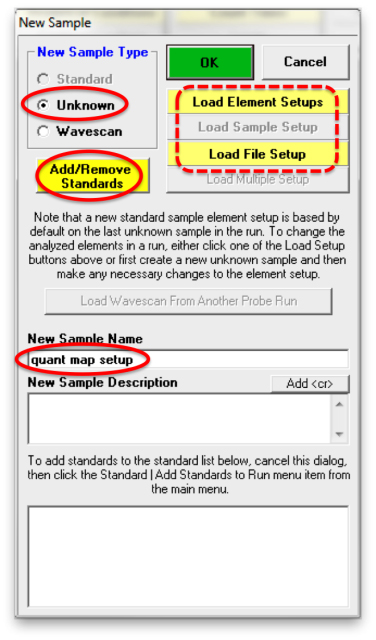
In this example we're loading a File Setup from a pyroxene run:
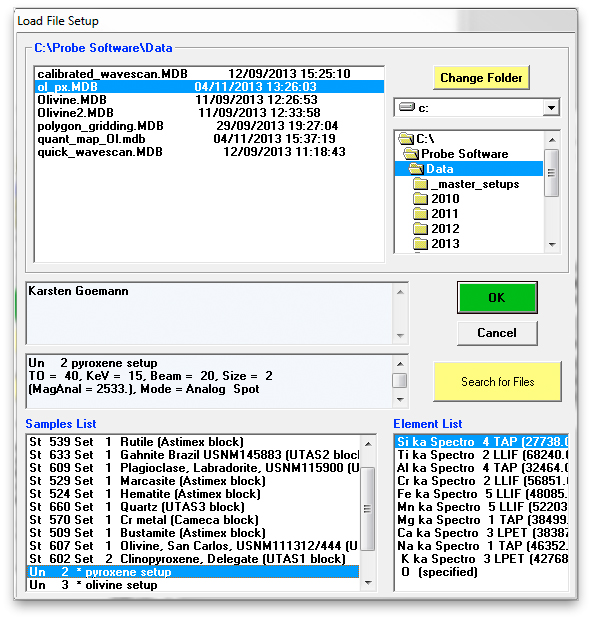
If the File Setup is linked to valid standard intensity measurements, they can be loaded as well. If the standards were acquired recently they might still be usable for map quantification, depending on instrument stability.
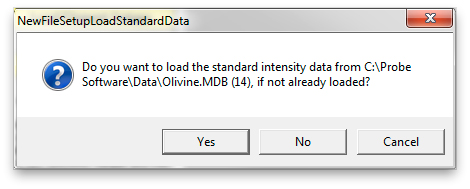
When finished, click OK, open the Elements/Cations window and adjust the element list as desired. In this example two elements are specified per spectrometer. During mapping, only one element can be acquired per WDS at a time so in this case we'll have to do two passes to acquire maps for all elements. However, for quantification in CalcImage all maps will be combined and a single PFE sample setup will be used.

Now click on an element row to open its Element Properties window. Although it is possible to choose different settings for standards acquisition and map quantification, we'll use the same settings for both and will set up everything as intended for the mapping right now. An important consideration for quantitative mapping is the background correction. Conventionally it requires acquisition of separate off-peak maps which substantially increases overall map acquisition time. Probe Image can collect up to 2 off-peak maps per element. To save acquisition time, a single off-peak map per element with a predetermined slope factor could be used. All background correction options available for point measurements can also be used for map quantification (linear, exponential, slope...) except for Multi-Point.
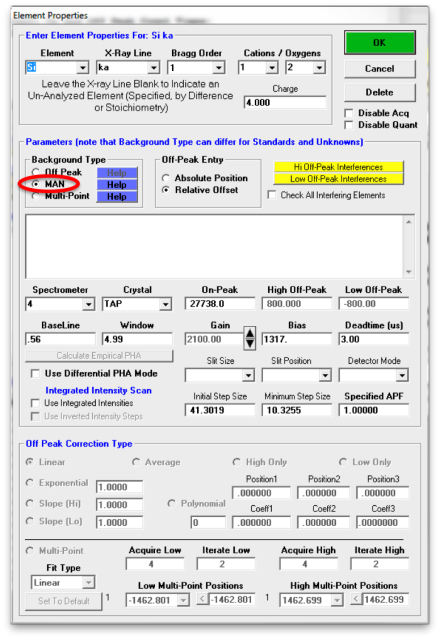
In this example we use MAN (mean atomic number) background correction which offers a powerful alternative for quantitative mapping, as it doesn't require off-peak measurements and therefore can save considerable instrument time. It requires setting up MAN calibration curves using standard measurements which is described in more detail elsewhere. MAN is normally only used for major elements but has been shown to work down to concentrations of 0.01 wt% under certain circumstances which need to be established carefully. MAN could potentially even be used for trace element mapping in simple unchanging matrices (e.g. Ti in quartz...) in combination with a "blank" correction. See this thread for more info on backgrounds in mapping:
http://probesoftware.com/smf/index.php?topic=103.0When finished with all elements, close the Elements/Cations window, and adjust parameters like analytical conditions, count times, and other acquisition options for the standards acquisition as you normally would for a point measurement run. These parameters will be set separately for the map acquisition in Probe Image. If you select the "Return to On Peaks After Acquisition" flag in the Acquisition Options window, the first set of elements on the WDS will already be set correctly in the Probewin.ELM element file for quick import into Probe Image.

Open the Analyze! window and click "Standard Assignments" to check/adjust primary standard assignments. At this point you can also specify interference and/or blank corrections which can also be used in quant mapping.
Open the Automate! window and digitize the standards. Select the "Peak Spectrometers" and "Peak on Assigned Standards" flags to perform an automated peaking as part of the standards acquisition if your instrument is set up to perform this reliably. Alternatively you can peak manually using the "Peaking Options" and "Start Peaking" buttons in the Acquire! window.

Select all standards to run and click "Run Selected Samples". After the standard acquisition is finished, check the results and delete any "bad" lines as you commonly would for a point acquisition run.
If using MAN background correction, select Analytical | Assign MAN fits in the main PFE window and to check and optimize the MAN calibration curves.
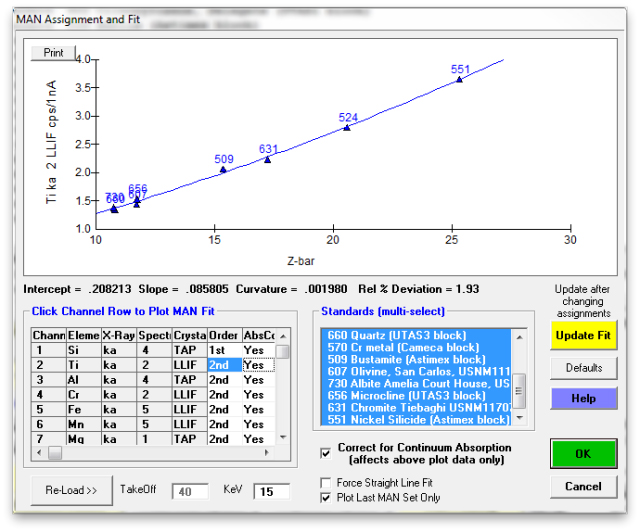
This completes the first part. The actual map acquisition in Probe Image and processing in CalcImage will be posted soon to the respective boards and linked here.
Any questions or suggestions, please fire away!
Cheers,
Karsten
Edit by John: Excellent summary Karsten! I would only add that one might also want to acquire a few "point analyses" on the unknown sample, just to compare with the map data (some high precision points for comparison with the x-ray maps). Or just a secondary standard as one normally would acquire, just to check for accuracy issues, for example even a standard sample, used as a primary standard for some elements, can still be utilized as an accuracy test for other elements (at least if not using the automatic "quick" standards option) as seen here:
St 358 Set 5 Diopside (Chesterman), Results in Elemental Weight Percents
ELEM: Na Al Si Mg Ca Fe Mn K S P Ti Cr Ni Co V Zn Cu O
TYPE: ANAL ANAL ANAL ANAL ANAL ANAL ANAL ANAL ANAL ANAL ANAL ANAL ANAL ANAL ANAL ANAL ANAL SPEC
BGDS: MAN MAN MAN MAN MAN MAN LIN LIN HIGH EXP LIN LIN LIN LIN LIN LIN LIN
TIME: 20.00 40.00 20.00 20.00 120.00 60.00 40.00 20.00 40.00 20.00 20.00 30.00 20.00 40.00 80.00 20.00 20.00
BEAM: 29.98 29.98 29.98 29.98 29.98 29.98 29.98 29.98 29.98 99.86 99.86 99.86 99.86 99.86 99.86 99.86 99.86
ELEM: Na Al Si Mg Ca Fe Mn K S P Ti Cr Ni Co V Zn Cu O SUM
460 -.026 .016 25.761 11.099 18.543 .042 .001 .017 -.003 .001 -.001 .002 .007 .001 -.003 -.010 .011 44.316 99.774
461 -.031 .015 25.616 11.070 18.450 .032 .001 -.003 .019 .005 -.006 .011 -.004 -.001 -.001 .009 -.012 44.316 99.487
462 -.008 .012 26.302 11.029 18.441 .034 .002 -.020 -.004 .002 -.006 .005 -.004 -.003 .002 -.005 -.002 44.316 100.095
463 .141 .011 25.968 11.122 18.526 .042 .005 .003 .000 .009 .004 .009 -.011 -.004 .001 -.011 .001 44.316 100.133
AVER: .019 .013 25.912 11.080 18.490 .037 .002 -.001 .003 .004 -.002 .007 -.003 -.002 .000 -.004 .000 44.316 99.872
SDEV: .082 .002 .298 .040 .052 .005 .002 .015 .011 .004 .005 .004 .007 .002 .002 .009 .009 .000 .303
SERR: .041 .001 .149 .020 .026 .003 .001 .008 .005 .002 .002 .002 .004 .001 .001 .005 .005 .000
%RSD: 429.52 17.72 1.15 .36 .28 13.92 104.92-2478.96 349.76 92.07 -219.87 56.32 -271.67 -136.11-1657.65 -214.81-1928.55 .00
PUBL: .015 .016 25.925 11.192 18.489 .047 .000 n.a. n.a. n.a. .000 n.a. n.a. n.a. n.a. n.a. n.a. 44.316 100.000
%VAR: 26.68 -15.92 (-.05) -1.00 (.01) -20.25 .00 --- --- --- .00 --- --- --- --- --- --- .00
As one can see above, the relative variance values ("%VAR") are comparing the measured average with the "published" standard value ("PUBL:"). The values in parentheses can be ignored as this is the primary standard for Si and Ca, but the Mg measurement is a true "secondary" standard measurement (as are all the other elements being measured- or at least a check on the zero concentration level), and we can see from the values in red, that we have a relative accuracy, in this case, of approximately 1% accuracy relative to MgO.